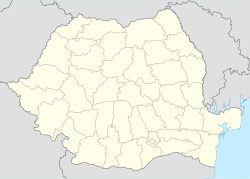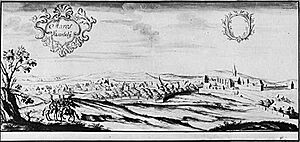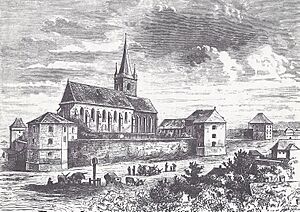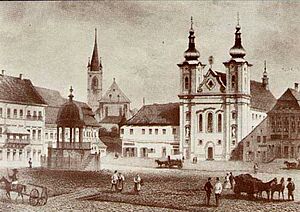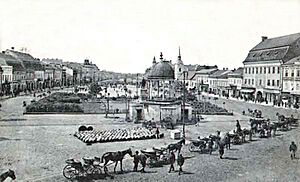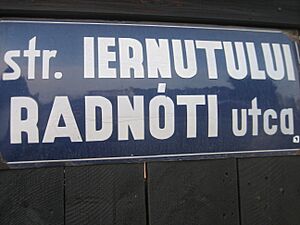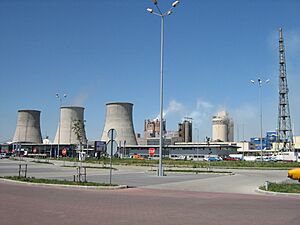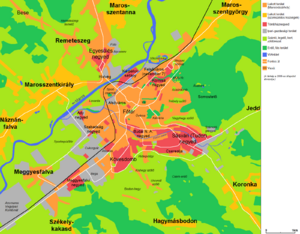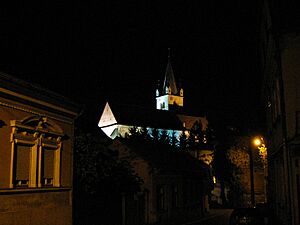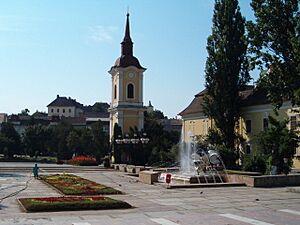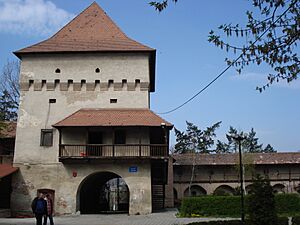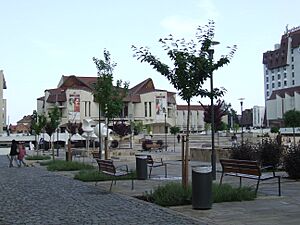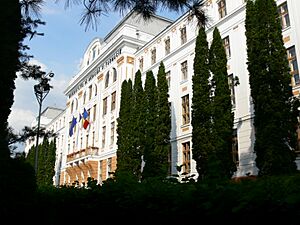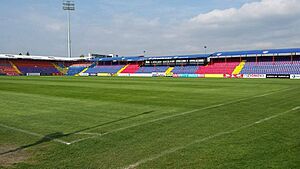Târgu Mureș facts for kids
Quick facts for kids
Târgu Mureș
Marosvásárhely
|
|||
|---|---|---|---|

Top left: Medieval Fortress and Tower of the Reformed Church, Top right: Bob Church, Middle left: Twilight in inner city, Center: The Reformed Church in Szabadi Street, Middle right: Tower of City Hall, Bottom left: Dome of the Synagogue, Bottom right: Statue of Bolyai Farkas and János in Bolyai Square
|
|||
|
|||
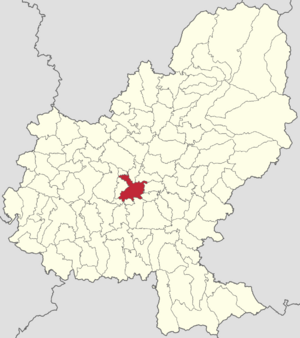
Location in Mureș County
|
|||
| Country | |||
| County | Mureș | ||
| Status | County capital | ||
| Area | |||
| • City | 49.3 km2 (19.0 sq mi) | ||
| Population
(2021-12-01)
|
|||
| • City | 116,033 | ||
| • Density | 2,593/km2 (6,720/sq mi) | ||
| • Metro | 212,752 | ||
| Demonym(s) | târgumureșean, târgumureșeancă (ro) vásárhelyi (hu) |
||
| Ethnicity | |||
| • Romanians | 51.9% | ||
| • Hungarians | 45.2% | ||
| • Roma | 2.5% | ||
| Time zone | UTC+02:00 (EET) | ||
| • Summer (DST) | UTC+03:00 (EEST) | ||
| Postal Code |
540xyz1
|
||
| Area code(s) | +40 x652 | ||
| Car Plates | MS-N3 | ||
| 1x, y, and z are digits that indicate the street, part of the street, or even the building of the address 2x is a digit indicating the operator: 2 for the former national operator, Romtelecom, and 3 for the other ground telephone networks 3used just on the plates of vehicles that operate only within the city limits (such as trolleybuses, trams, utility vehicles, ATVs, etc.) |
|||
Târgu Mureș is a city in Romania. It is the main city of Mureș County. You can find it in the historical region of Transylvania. Târgu Mureș is the 16th largest city in Romania. In 2021, about 116,033 people lived there. The city is located on the Mureș River. This river is the second longest in Romania, after the Danube.
Contents
City Names and Their Meanings
The name Târgu Mureș in Romanian means "market on the Mureș River". The Hungarian name, Marosvásárhely, means the same thing. Târg means "market" in Romanian. Vásárhely means "marketplace" in Hungarian. Local Hungarians often call it simply Vásárhely.
The city was first mentioned in writing in 1230. A priest named Martin Szentiványi wrote about it. He called it Asserculis, which meant Szekely Vasarhely.
In 1332, it was called Novum Forum Siculorum in Latin. This means "New Szekler Marketplace". Later, in 1349, it was called Sekulvasarhel. This means "market of the Székelys". Greek traders also had names for it, like "Agropolis" or "Areopolis".
In 1616, Gabriel Bethlen made it a royal free city. He officially named it Marosvásárhely. The German name was Neumarkt am Mieresch. This translates to "New Market".
After World War I, the city became part of Romania. Its name changed to Oșorheiu. The name Târgu Mureș became popular later. After World War II, the spelling changed to Tîrgu Mureș. In 1993, it officially became "Târgu Mureș" again.
History of Târgu Mureș

The first time the city was officially written about was in 1332. It was called Novum Forum Siculorum in Latin. This means "New Szekler Marketplace".
Before 1332, a church stood where the Fortress' Church is now. It was destroyed during the Mongol invasion. The current Fortress' Church was built around 1332.
In 1405, King Sigismund allowed the city to hold fairs. This helped the city grow. From 1439, the Transylvanian parliament met here many times. In 1470, King Matthias Corvinus gave the city special legal rights.
In 1557, the Reformed Church College was founded. It was the oldest Hungarian school in Transylvania. In 1616, Târgu Mureș became a free royal city. This was granted by Prince Gábor Bethlen.
In 1658, Ottoman and Tartar armies attacked the city. They burned it down and took 3,000 people captive. The city was rebuilt, but faced more challenges. In 1662, a fire destroyed most of the city. In 1687, German imperial troops also caused damage.
The city became more important in 1754. It became home to the Supreme Court of Justice for Transylvania. In 1802, the Teleki Library opened. It was founded by Count Sámuel Teleki and had 40,000 books.
Avram Iancu, a leader in the 1848 Romanian revolution, was a young lawyer here. He fought for the rights of Romanians in Transylvania.
In the late 1800s and early 1900s, the city changed a lot. In 1913, the beautiful City Hall and Palace of Culture were opened. This was part of Mayor Bernády György's plan to modernize the city.
After World War I, Târgu Mureș became part of Romania. The number of Romanian people in the city grew over time.
From 1940 to 1944, the city was given back to Hungary. During this time, a Jewish ghetto was set up. Târgu Mureș returned to Romanian rule in October 1944.
After World War II, the communist government built many factories. This changed the city a lot. From 1950 to 1968, Târgu Mureș was the center of the Magyar Autonomous Region.
In March 1990, after the communist rule ended, there were some disagreements between different ethnic groups in the city.
In the 21st century, the city's economy has grown. Many new businesses have opened. In 2020, Zoltán Soós became mayor. He was the first ethnic Hungarian to win in twenty years.
Geography
The city is in the Mureș River valley. It covers an area of about 49.3 square kilometers. The city center grew around the Fortress Church, built in the 14th century.
Târgu Mureș is in the middle of Transylvania. It sits where three different geographical areas meet. These are the Transylvanian Plain, the Mureș Valley, and the Niraj Valley. The city is about 330 meters above sea level. Most of the city is on the left bank of the Mureș river. The Cornești plateau is the highest point, at 465 meters above sea level.
Târgu Mureș is 337 km from Bucharest. It is also close to other major Romanian cities:
- Brașov: 168 km by road
- Cluj-Napoca: 101 km by road
- Sibiu: 112 km by road
- Timișoara: 327 km by road
Climate
Târgu Mureș has a continental climate. This means it has warm, dry summers. Winters are usually cold. Temperatures in winter often drop below 0°C. The city gets snow about 38 days a year. Snow stays on the ground for more than 60 days.
In summer, the average temperature is between 18°C and 19°C. But it can sometimes reach 36°C. The city has about 143 days with rain or snow each year. December has the most rainy days, and August, September, and October have the fewest.
The average yearly temperature in Târgu Mureș is 8.6°C. The coldest temperature ever recorded was -32.8°C in 1942 and 1963. The hottest was 39°C in 1936.
| Climate data for Târgu Mureș (Elevation: 320 m or 1,050 ft) | |||||||||||||
|---|---|---|---|---|---|---|---|---|---|---|---|---|---|
| Month | Jan | Feb | Mar | Apr | May | Jun | Jul | Aug | Sep | Oct | Nov | Dec | Year |
| Record high °C (°F) | 14.0 (57.2) |
19.0 (66.2) |
27.0 (80.6) |
32.5 (90.5) |
34.4 (93.9) |
35.3 (95.5) |
39.0 (102.2) |
38.5 (101.3) |
38.2 (100.8) |
31.5 (88.7) |
26.5 (79.7) |
18.3 (64.9) |
39.0 (102.2) |
| Mean daily maximum °C (°F) | 0.6 (33.1) |
3.6 (38.5) |
9.9 (49.8) |
16.0 (60.8) |
21.0 (69.8) |
23.7 (74.7) |
25.2 (77.4) |
25.2 (77.4) |
21.7 (71.1) |
16.0 (60.8) |
8.4 (47.1) |
2.4 (36.3) |
14.5 (58.1) |
| Daily mean °C (°F) | −3.9 (25.0) |
−0.9 (30.4) |
4.5 (40.1) |
10.0 (50.0) |
14.8 (58.6) |
17.7 (63.9) |
19.0 (66.2) |
18.7 (65.7) |
15.2 (59.4) |
9.8 (49.6) |
4.2 (39.6) |
−1.1 (30.0) |
9.0 (48.2) |
| Mean daily minimum °C (°F) | −8.3 (17.1) |
−5.4 (22.3) |
−0.8 (30.6) |
4.0 (39.2) |
8.7 (47.7) |
11.7 (53.1) |
12.9 (55.2) |
12.3 (54.1) |
8.7 (47.7) |
3.6 (38.5) |
0.0 (32.0) |
−4.6 (23.7) |
3.6 (38.4) |
| Record low °C (°F) | −32.8 (−27.0) |
−32.0 (−25.6) |
−27.3 (−17.1) |
−7.5 (18.5) |
−1.6 (29.1) |
0.3 (32.5) |
4.6 (40.3) |
2.7 (36.9) |
−3.3 (26.1) |
−8.4 (16.9) |
−19.6 (−3.3) |
−25.9 (−14.6) |
−32.8 (−27.0) |
| Average precipitation mm (inches) | 31.0 (1.22) |
27.0 (1.06) |
27.0 (1.06) |
49.0 (1.93) |
73.0 (2.87) |
89.0 (3.50) |
84.0 (3.31) |
65.0 (2.56) |
45.0 (1.77) |
39.0 (1.54) |
35.0 (1.38) |
36.0 (1.42) |
600 (23.62) |
| Average precipitation days | 15 | 12 | 13 | 14 | 13 | 13 | 11 | 8 | 8 | 8 | 12 | 16 | 143 |
| Average rainy days | 5 | 6 | 11 | 13 | 13 | 13 | 11 | 8 | 8 | 8 | 10 | 8 | 114 |
| Average snowy days | 11 | 8 | 3 | 1 | 0 | 0 | 0 | 0 | 0 | 0 | 4 | 11 | 38 |
| Source 1: Weatherbase.com | |||||||||||||
| Source 2: Climate-data.org | |||||||||||||
People and Languages
In 2021, Târgu Mureș had 116,033 people. The city has the largest group of Hungarian people in Transylvania. In 2002, Hungarian people became a minority in the city for the first time.
The city uses both Romanian and Hungarian languages officially. You can see both languages on public signs. They are also used in schools and government offices. About 2.97% of the city's population are Roma people.
Ethnic composition of Târgu Mureș (2021) Romanians (54.83%) Hungarians (41.81%) Romani (2.97%) Germans (Transylvanian Saxons) (0.12%) Jews (0.04%) Others (0.21%)
Religious composition of Târgu Mureș (2021) Romanian Orthodox (48.67%) Reformed (27.02%) Roman Catholics (12.67%) Unitarians (2.50%) Greek Catholics (2.44%) Jehovah's Witnesses (1.29%) Others (3.56%) Irreligious,atheist and agnostic (1.86%)
How the Population Changed
Here's how the different groups of people in Târgu Mureș have changed over time:
| Year | Total | Romanians | Hungarians | Germans | Jews | Roma | Others |
|---|---|---|---|---|---|---|---|
| 1850 | 7,855 | 6.0% | 82.6% | 3.1% | 2.6% | 3.6% | 2.1% |
| 1869 | 12,678 | 5.2% | 88.9% | 3.5% | n.a. | n.a. | 2.4% |
| 1900 | 20,229 | 11.6% | 83.3% | 3.6% | n.a. | n.a. | 1.5% |
| 1910 | 25,517 | 6.7.% | 89.3% | 2.4% | n.a. | n.a. | 1.6% |
| 1930 | 40,058 | 26.7% | 57.2% | 1.7% | 12.1% | 1.1% | 1.2% |
| 1966 | 86,464 | 28.3% | 70.9% | 0.6% | n.a. | n.a. | 0.2% |
| 1977 | 127,783 | 34.8% | 63.6% | 0.6% | 0.4% | 0.5% | 0.1% |
| 1992 | 164,445 | 46.1% | 51.4% | 0.3% | 0.1% | 2% | 0.1% |
| 2002 | 149,577 | 50.4% | 46.7% | 0.2% | n.a. | 2.4% | 0.3% |
| 2011 | 134,290 | 51.9% | 45.2% | 0.2% | 0.1% | 2.4% | 0.1% |
| 2021 | 116,033 | 54.8% | 41.8% | 0.1% | 0.0% | 3.0% | 0.2% |
Economy
Târgu Mureș has a strong economy. There are over 8,500 private companies here. There are also several companies owned by the state.
The city is known for different types of industries:
- Chemical industry: like the Azomureș plant.
- Pharmaceutical industry: making medicines.
- Food industry: including bread and dairy products.
- Wood industry: processing wood.
- Textile industry: making fabrics and clothes.
City Districts
Târgu Mureș is divided into several districts. Here are their names in both Romanian and Hungarian:
| in Romanian | in Hungarian |
|---|---|
| Centru | Főtér |
| Dâmbul Pietros (1848) | Kövesdomb (1848) |
| Unirii (on the right of the Mureș River) | Egyesülés (i.e. Benefalva and Hídvég villages
on the right of the Mureș River) |
| Rovinari | Ady Endre |
| Aleea Carpați | Kárpátok sétánya |
| Budai Nagy Antal | Budai Nagy Antal |
| Gară | Állomás |
| Livezeni | Jedd |
| 22 Decembrie 1989 (7 Noiembrie) | 1989 December 22 (7 November) |
| Tudor Vladimirescu | Tudor Vladimirescu |
| Răsăritului | Kikelet |
| Mureșeni | Meggyesfalva |
| Substejăriș | Cserealja |
| Cornișa | Párkány |
| Valea Rece | Hidegvölgy |
Famous People from Târgu Mureș
Many important people were born or lived in Târgu Mureș. They helped shape the city in many ways.
Petru Maior (1756–1821)
Elek Dósa (1803–1867)
Farkas Deák (1832–1888)
Vasile Hossu (1866–1916)
Gyula Vályi (1855–1913)
Gyula Ostenburg-Moravek (1884–1944)
József Molnár (1907–1983)
József Dudás (1912–1957)
Sergiu Al-George (1922–1981)
Alexandru Imre (born 1924)
Tibor Diamantstein (1925–1995)
Zoltán Nuridsány (1925–1974)
Irina Klimovschi (1936–2001)
Boldizsár Csiky (born 1937)
Ferenc Asztalos (born 1945)
Gabriel Herman (born 1947)
Rozalia Șooș (born 1947)
György Frunda (born 1951)
László Bölöni (born 1953)
Maria Mailat (born 1953)
Géza Szőcs (1953–2020)
László Borbély (born 1954)
Radu Filipescu (born 1955)
Gábor Tompa (born 1957)
Ildikó Keresztes (born 1964)
Kata Tisza (born 1980)
Călin Târnăvean (born 1984)
Bernadette Szőcs (born 1995)
Ilinca Băcilă (born 1998)
Filip Ugran (born 2002)
Péter Csokás (d. 1587)
Péter Apor (1676–1752)
György Aranka (1737–1817)
Sámuel Teleki (1739–1832)
Gheorghe Șincai (1754–1816)
Farkas Bolyai (1775–1856)
János Bolyai (1802–1860)
Avram Iancu (1824–1872)
Alexandru Papiu Ilarian (1827–1877)
György Bernády (1864–1938)
Károly Molter (1890–1981)
Aurel Filimon (1891–1940)
Emil Dandea (1893–1969)
János Kemény (1903–1971)
Márton Izsák (1913–2004)
Loránd Lohinszky (1925–2013)
András Sütő (1927–2006)
Romulus Guga (1939–1983)
György Orbán (born 1947)
Raed Arafat (born 1964)
Main Sights to See
Places of Worship
The Reformed Fortress Church is the oldest church in Târgu Mureș. It was built between the mid-1300s and mid-1400s. It included a monastery, an old chapel, the church, and a tall tower. The church might have had colorful paintings inside. These paintings disappeared when the church became Protestant in 1557. Protestant churches usually do not have many paintings or statues.
The Franciscan friars, who used to be at the fortress church, had to leave in 1557. They came back almost 200 years later. They built a new church and monastery by 1777. Only the tower of this church is still standing today. In 1971, the monastery was taken down to make space for the National Theater. A new church for the Franciscans was built in 1972.
The St John the Baptist Church was built in the early 1700s. It is a beautiful Baroque-style church. It belongs to the Roman Catholic community. Inside, the church is very fancy. It has amazing art, like the main altar made in 1755. The stained glass windows were put in in 1898.
The Great Synagogue was built from 1899 to 1900. It was built by the Jewish community. The building has a large dome in the middle. Its inside is richly decorated with shapes and colors. The synagogue has many seats for people to gather. It was last updated in 2000.
The Unitarian faith in Târgu Mureș started with Ferenc Dávid. He was the founder of Unitarianism. In the 1500s, people in Transylvania were given freedom to choose their religion. Unitarianism became an accepted religion. The Unitarian Church was built between 1929 and 1930.
Other Interesting Sights
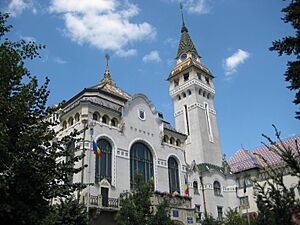
The first fortress in the city was built in 1492. It was finished between 1602 and 1652. The Citadel has a five-sided shape. It has seven forts, named after the guilds that helped maintain them. These guilds were groups of skilled workers. The Citadel later became a military base. Today, a museum inside the gate fort shows the history of the town.
The Teleki-Bolyai Library is a very old public library. It is also a museum. Count Sámuel Teleki founded it in 1802. It has been open to the public ever since. The library holds over 200,000 books, many of them very rare. It is an important collection of Transylvanian books.
The old City Hall was built from 1906 to 1907. It was designed by Márcell Komor and Dezső Jakab. The entrance and staircase are very impressive. They have beautiful arched ceilings and decorated columns. The outside of the building has colorful ceramic decorations. These designs are inspired by Hungarian folk art.
The Palace of Culture is a famous building in the city center. Mayor György Bernády started its construction in 1911. The building has five floors. Its outside is richly decorated with colorful mosaic panels. These mosaics show scenes from Hungarian folklore. The city skyline can be seen from Cornești Heights.
Culture
Târgu Mureș has a rich culture. The Palace of Culture has a concert hall. The Târgu Mureș State Philharmonic Orchestra performs classical concerts there every week.
The Târgu Mureș National Theater has two groups. One performs in Hungarian, and the other in Romanian. There are also smaller, independent theater groups.
The city used to host the Peninsula / Félsziget Festival. This was once Romania's biggest music festival.
Education
Târgu Mureș is an important place for learning. It has many schools and universities. Some important high schools are the Alexandru Papiu Ilarian National College and Unirea National College.
The Hungarian-speaking Bolyai Farkas Elméleti Líceum is also here. It continues the traditions of a school from 1557. This school was one of the first Reformed Church schools in Transylvania.
Târgu Mureș also has a "School of Arts." It started in 1949. This school helps young musicians and artists. Students learn music theory, play instruments, and study graphic arts.
There are also well-known public universities. The University of Medicine, Pharmacy, Science and Technology (UMFST) was founded in 1945. The University of Arts started in 1946. More than 10,000 students attend these universities. Other universities include Sapientia University and Dimitrie Cantemir University.
Transport
Roads
Several important roads pass through or near Târgu Mureș. These include DN13, DN15, DN15E, and E60. The Transylvania Motorway is being built near the city. Another highway, the East-West Motorway (A8), will also connect to Târgu Mureș.
Trains
Romanian trains are run by Căile Ferate Române (CFR). Târgu Mureș has three train stations: South, Central, and North. They offer both local and international train services. The city is a main stop for some routes of MÁV.
Airport
The city has its own airport, Târgu Mureș Transilvania Airport. It offers flights within Romania and to other countries. The airport was updated in 2005. It is the second busiest airport in Transylvania.
Public Transport
Only buses are used for public transport in the city. The company that runs the buses is SC Transport Local SA. Since 2020, there have been many changes to public transport. New bus lines have been added, including some just for students. The bus fleet has been updated with newer buses. You can also pay for tickets digitally. On weekends and holidays, bus trips are free. Students can also ride for free with a special bus pass.
-
BMC Procity 12 diesel buses.
-
Mercedes-Benz Conecto Hybrid buses.
Sports
Târgu Mureș has teams in many sports. These include football, handball, basketball, futsal, and volleyball.
There are two football teams in the city: CSM Târgu Mureș and ACS MSE Târgu Mureș. In the past, ASA Târgu Mureș was very successful. They played in the UEFA Cup three times in the 1970s. Another team, ASA 2013 Târgu Mureș, won the 2015 Romanian Super Cup.
BC Mureș is the city's basketball team. They play in the top Romanian league. In the 2012–13 season, they finished second in the league.
CSU Medicina is the women's volleyball team. They have been in the top Romanian volleyball league for many years.
Târgu Mureș is also known for its bowling team, Electromureș. The city's futsal team, City'us Târgu Mureș, has won the national championship three times. They have also played in the UEFA Futsal Champions League.
Romania's largest racetrack, Transilvania Motor Ring, is located near the city.
Military
The main office for the Romanian Special Operations Forces Command is in Târgu-Mureș.
Local Media
|
|
|
Twin Cities
Târgu Mureș is connected with other cities around the world. These are called twin towns or sister cities:
|
See also
 In Spanish: Târgu Mureș para niños
In Spanish: Târgu Mureș para niños




